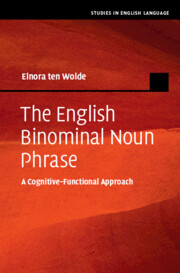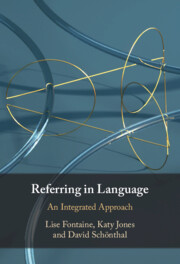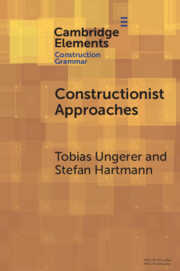Refine search
Actions for selected content:
6584 results in Grammar and Syntax
List of Contributors
-
- Book:
- New Perspectives on English Word Stress
- Published by:
- Edinburgh University Press
- Published online:
- 15 March 2025
- Print publication:
- 04 July 2023, pp xii-xiii
-
- Chapter
- Export citation
Frontmatter
-
- Book:
- New Perspectives on English Word Stress
- Published by:
- Edinburgh University Press
- Published online:
- 15 March 2025
- Print publication:
- 04 July 2023, pp i-iv
-
- Chapter
- Export citation
7 - Melodic Complexity and Lexical Stress in Singapore English: An Experimental Study
-
-
- Book:
- New Perspectives on English Word Stress
- Published by:
- Edinburgh University Press
- Published online:
- 15 March 2025
- Print publication:
- 04 July 2023, pp 240-263
-
- Chapter
- Export citation

The English Binominal Noun Phrase
- A Cognitive-Functional Approach
-
- Published online:
- 29 June 2023
- Print publication:
- 13 July 2023

Referring in Language
- An Integrated Approach
-
- Published online:
- 22 June 2023
- Print publication:
- 25 May 2023

Constructionist Approaches
- Past, Present, Future
-
- Published online:
- 22 June 2023
- Print publication:
- 20 July 2023
-
- Element
-
- You have access
- Open access
- HTML
- Export citation
16 - Extraction Restrictions in Complex Sentences
- from Part Three - Topics in RRG: Complex Sentences
-
-
- Book:
- The Cambridge Handbook of Role and Reference Grammar
- Published online:
- 08 June 2023
- Print publication:
- 22 June 2023, pp 616-644
-
- Chapter
- Export citation
6 - Argument Structure Alternations
- from Part Two - Topics in RRG: Simple Sentences
-
-
- Book:
- The Cambridge Handbook of Role and Reference Grammar
- Published online:
- 08 June 2023
- Print publication:
- 22 June 2023, pp 292-317
-
- Chapter
- Export citation
23 - A Grammatical Sketch of Yimas (Lower Sepik, Papua New Guinea)
- from Part Five - Grammatical Sketches
-
-
- Book:
- The Cambridge Handbook of Role and Reference Grammar
- Published online:
- 08 June 2023
- Print publication:
- 22 June 2023, pp 861-888
-
- Chapter
- Export citation
4 - Semantic Macroroles
- from Part Two - Topics in RRG: Simple Sentences
-
-
- Book:
- The Cambridge Handbook of Role and Reference Grammar
- Published online:
- 08 June 2023
- Print publication:
- 22 June 2023, pp 242-268
-
- Chapter
- Export citation
8 - Morphology in RRG
- from Part Two - Topics in RRG: Simple Sentences
-
-
- Book:
- The Cambridge Handbook of Role and Reference Grammar
- Published online:
- 08 June 2023
- Print publication:
- 22 June 2023, pp 368-402
-
- Chapter
- Export citation
Part Five - Grammatical Sketches
-
- Book:
- The Cambridge Handbook of Role and Reference Grammar
- Published online:
- 08 June 2023
- Print publication:
- 22 June 2023, pp 821-982
-
- Chapter
- Export citation
18 - Functional Acquisition Processes in Child Language
- from Part Four - Applications of RRG
-
-
- Book:
- The Cambridge Handbook of Role and Reference Grammar
- Published online:
- 08 June 2023
- Print publication:
- 22 June 2023, pp 666-692
-
- Chapter
- Export citation
Contributors
-
- Book:
- The Cambridge Handbook of Role and Reference Grammar
- Published online:
- 08 June 2023
- Print publication:
- 22 June 2023, pp xxii-xxii
-
- Chapter
- Export citation
26 - Case and Voice in Amis (Austronesian, Taiwan)
- from Part Five - Grammatical Sketches
-
-
- Book:
- The Cambridge Handbook of Role and Reference Grammar
- Published online:
- 08 June 2023
- Print publication:
- 22 June 2023, pp 954-982
-
- Chapter
- Export citation
15 - Cleft Sentences and Relative Clauses
- from Part Three - Topics in RRG: Complex Sentences
-
-
- Book:
- The Cambridge Handbook of Role and Reference Grammar
- Published online:
- 08 June 2023
- Print publication:
- 22 June 2023, pp 591-615
-
- Chapter
- Export citation
1 - Principles of Role and Reference Grammar
- from Part One - Overview
-
-
- Book:
- The Cambridge Handbook of Role and Reference Grammar
- Published online:
- 08 June 2023
- Print publication:
- 22 June 2023, pp 17-178
-
- Chapter
- Export citation
11 - The RRG Approach to Information Structure
- from Part Two - Topics in RRG: Simple Sentences
-
-
- Book:
- The Cambridge Handbook of Role and Reference Grammar
- Published online:
- 08 June 2023
- Print publication:
- 22 June 2023, pp 456-487
-
- Chapter
- Export citation
7 - Case Assignment
- from Part Two - Topics in RRG: Simple Sentences
-
-
- Book:
- The Cambridge Handbook of Role and Reference Grammar
- Published online:
- 08 June 2023
- Print publication:
- 22 June 2023, pp 318-367
-
- Chapter
- Export citation
Pedagogical Guide to The Cambridge Handbook of Role and Reference Grammar
-
- Book:
- The Cambridge Handbook of Role and Reference Grammar
- Published online:
- 08 June 2023
- Print publication:
- 22 June 2023, pp xxiii-xxiv
-
- Chapter
- Export citation
